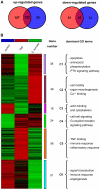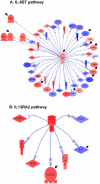Coxiella burnetii, the agent of Q fever, replicates within trophoblasts and induces a unique transcriptional response
- PMID: 21179488
- PMCID: PMC3001886
- DOI: 10.1371/journal.pone.0015315
Coxiella burnetii, the agent of Q fever, replicates within trophoblasts and induces a unique transcriptional response
Abstract
Q fever is a zoonosis caused by Coxiella burnetii, an obligate intracellular bacterium typically found in myeloid cells. The infection is a source of severe obstetrical complications in humans and cattle and can undergo chronic evolution in a minority of pregnant women. Because C. burnetii is found in the placentas of aborted fetuses, we investigated the possibility that it could infect trophoblasts. Here, we show that C. burnetii infected and replicated in BeWo trophoblasts within phagolysosomes. Using pangenomic microarrays, we found that C. burnetii induced a specific transcriptomic program. This program was associated with the modulation of inflammatory responses that were shared with inflammatory agonists, such as TNF, and more specific responses involving genes related to pregnancy development, including EGR-1 and NDGR1. In addition, C. burnetii stimulated gene networks organized around the IL-6 and IL-13 pathways, which both modulate STAT3. Taken together, these results revealed that trophoblasts represent a protective niche for C. burnetii. The activation program induced by C. burnetii in trophoblasts may allow bacterial replication but seems unable to interfere with the development of normal pregnancy. Such pathophysiologocal processes should require the activation of immune placental cells associated with trophoblasts.
Conflict of interest statement
Figures





Similar articles
-
Infection and Persistence of Coxiella burnetii Clinical Isolate in the Placental Environment.Int J Mol Sci. 2023 Jan 7;24(2):1209. doi: 10.3390/ijms24021209. Int J Mol Sci. 2023. PMID: 36674725 Free PMC article.
-
Persistent Coxiella burnetii infection in mice overexpressing IL-10: an efficient model for chronic Q fever pathogenesis.PLoS Pathog. 2008 Feb 8;4(2):e23. doi: 10.1371/journal.ppat.0040023. PLoS Pathog. 2008. PMID: 18248094 Free PMC article.
-
Interleukin-10 stimulates Coxiella burnetii replication in human monocytes through tumor necrosis factor down-modulation: role in microbicidal defect of Q fever.Infect Immun. 2001 Apr;69(4):2345-52. doi: 10.1128/IAI.69.4.2345-2352.2001. Infect Immun. 2001. PMID: 11254592 Free PMC article.
-
Intracellular life of Coxiella burnetii in macrophages.Ann N Y Acad Sci. 2009 May;1166:55-66. doi: 10.1111/j.1749-6632.2009.04515.x. Ann N Y Acad Sci. 2009. PMID: 19538264 Review.
-
History and prospects of Coxiella burnetii research.Adv Exp Med Biol. 2012;984:1-11. doi: 10.1007/978-94-007-4315-1_1. Adv Exp Med Biol. 2012. PMID: 22711624 Review.
Cited by
-
Coxiella burnetii Lipopolysaccharide: What Do We Know?Int J Mol Sci. 2017 Nov 23;18(12):2509. doi: 10.3390/ijms18122509. Int J Mol Sci. 2017. PMID: 29168790 Free PMC article. Review.
-
The gene expression analysis of blood reveals S100A11 and AQP9 as potential biomarkers of infective endocarditis.PLoS One. 2012;7(2):e31490. doi: 10.1371/journal.pone.0031490. Epub 2012 Feb 3. PLoS One. 2012. PMID: 22319637 Free PMC article.
-
The effect of C. burnetii infection on the cytokine response of PBMCs from pregnant goats.PLoS One. 2014 Oct 3;9(10):e109283. doi: 10.1371/journal.pone.0109283. eCollection 2014. PLoS One. 2014. PMID: 25279829 Free PMC article.
-
Acute Q fever in third trimester pregnancy.BMJ Case Rep. 2021 Aug 13;14(8):e242558. doi: 10.1136/bcr-2021-242558. BMJ Case Rep. 2021. PMID: 34389589 Free PMC article.
-
Intracellular bacteria interfere with dendritic cell functions: role of the type I interferon pathway.PLoS One. 2014 Jun 10;9(6):e99420. doi: 10.1371/journal.pone.0099420. eCollection 2014. PLoS One. 2014. PMID: 24915541 Free PMC article.
References
-
- Raoult D, Marrie T, Mege JL. Natural history and pathophysiology of Q fever. Lancet Infect Dis. 2005;5:219–226. - PubMed
-
- Carcopino X, Raoult D, Bretelle F, Boubli L, Stein A. Managing Q fever during pregnancy: the benefits of long-term cotrimoxazole therapy. Clin Infect Dis. 2007;45:548–555. - PubMed
-
- Stein A, Lepidi H, Mege JL, Marrie TJ, Raoult D. Repeated pregnancies in BALB/c mice infected with Coxiella burnetii cause disseminated infection, resulting in stillbirth and endocarditis. J Infect Dis. 2000;181:188–194. - PubMed
-
- Arricau-Bouvery N, Rodolakis A. Is Q fever an emerging or re-emerging zoonosis? Vet Res. 2005;36:327–349. - PubMed
Publication types
MeSH terms
Substances
LinkOut - more resources
Full Text Sources
Molecular Biology Databases
Miscellaneous

